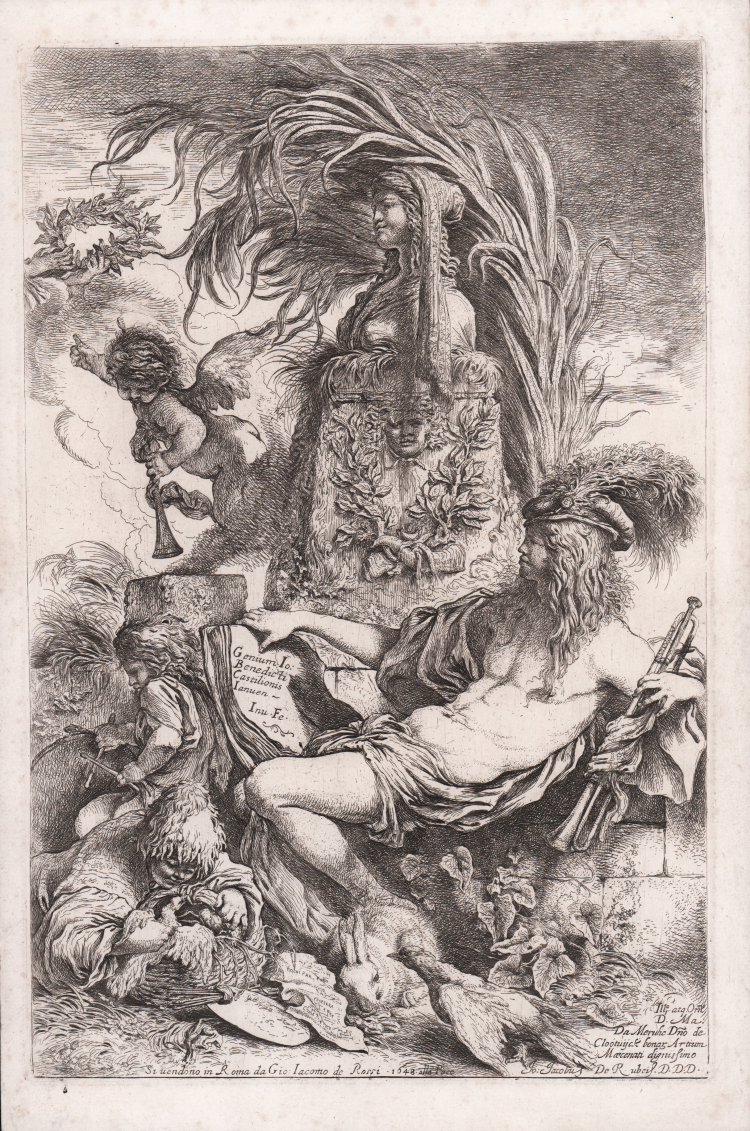



| Reference: | S42690 |
| Author | Giovanni Benedetto CASTIGLIONE detto "Il Grechetto" |
| Year: | 1640 ca. |
| Measures: | 247 x 370 mm |


| Reference: | S42690 |
| Author | Giovanni Benedetto CASTIGLIONE detto "Il Grechetto" |
| Year: | 1640 ca. |
| Measures: | 247 x 370 mm |
Example of the second state of three, with the address of Giacomo de Rossi and the date 1648.
Beautiful impression, printed on contemporary laid paper without watermark, with margins, slight oxidation in the margins, overall in excellent condition.
The engraving is datable to the Genoese period of the artist (1640/47), although printed in Rome, and bears the dedication to the noble Matthias van de Merwede, German collector and patron of the arts who between 1647 and 1650 was in Rome, Venice and Naples. The work depicts a young male figure, lying half-naked, holding a trumpet and a book, where the title of the composition and the signature of the author appear. A putto with a trumpet and a laurel wreath are the outline, symbolizing the iconography of Fame. The still life in the foreground composed of the basket of chicks and the rabbit symbolizes fertility, while the painter's palette and the music sheet are symbols of the glory of the arts. At a first analysis the composition seems therefore a serene allegory, distant from the dramatic works of the same period, such as Melanconia and Temporalis Aeternitas.
On closer inspection, however, elements such as the sepulchral monument in the center, conspicuously corroded and covered with grasses, and the way in which the palette and the musical score appear to have been thrown to the ground, allow the sense of the transience of human life, typical of Castiglione's mature works, to emerge.
The vanity of human activities, the meditation of the contemplative life, the emptiness and the memento mori are the emotions that the work of the Genius transmits, one of the absolute masterpieces of seventeenth-century graphics.
Bibliografia
Bartsch 23; Bellini 56 II/III.
Giovanni Benedetto CASTIGLIONE detto "Il Grechetto" (Genova 1616 - Mantova 1670)
|
His origin and his edication in Genua led Castiglione to make acquaitance with the Flemish painting, especially through Jaan Roos e Van Dyck from whom he took the warm, vibrating chromatism.
He lived in Rome from 1632 to 1635 and from 1647 to 1651; among the two periods in Rome, he lived in Naples and he also started studying the intellectualistic classicism of Poussin.
His favourite subjects, both in painting and engraving, were taken from the classical moralism of Stoicism, very typical in Poussin, which enabled him to create his own peculiar repertoire, much more refined in comparison with contemporary artists.
He spent his last working years in Mantua, at the Duke’s Palace; the production of this period enhances his chromatism and the visionary elements of his previous production.
Castiglione has been a silful engraver; he loved this particular art for he thought it was the main mean to widespread his iconography. He was the first, in Italy, to appreciate and imitate Rembrandt.
|
Giovanni Benedetto CASTIGLIONE detto "Il Grechetto" (Genova 1616 - Mantova 1670)
|
His origin and his edication in Genua led Castiglione to make acquaitance with the Flemish painting, especially through Jaan Roos e Van Dyck from whom he took the warm, vibrating chromatism.
He lived in Rome from 1632 to 1635 and from 1647 to 1651; among the two periods in Rome, he lived in Naples and he also started studying the intellectualistic classicism of Poussin.
His favourite subjects, both in painting and engraving, were taken from the classical moralism of Stoicism, very typical in Poussin, which enabled him to create his own peculiar repertoire, much more refined in comparison with contemporary artists.
He spent his last working years in Mantua, at the Duke’s Palace; the production of this period enhances his chromatism and the visionary elements of his previous production.
Castiglione has been a silful engraver; he loved this particular art for he thought it was the main mean to widespread his iconography. He was the first, in Italy, to appreciate and imitate Rembrandt.
|